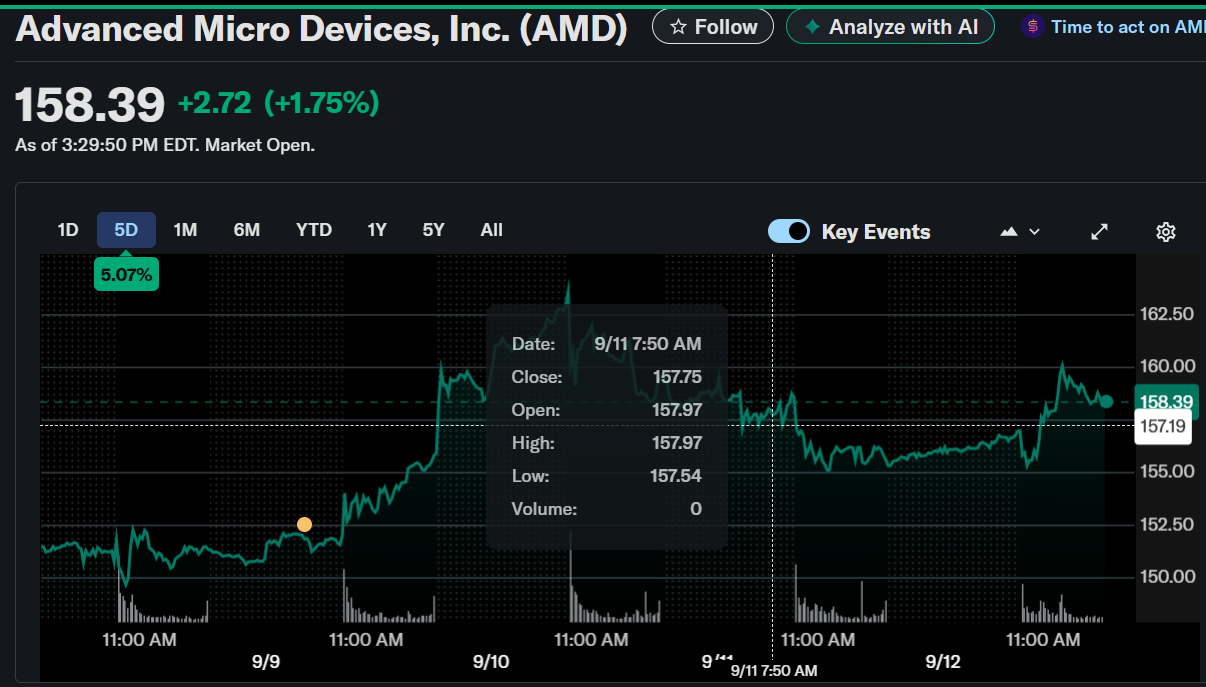AMD (AMD) Stock: Surges as Ryzen AI Max+ 395 Powers Mini AI Workstation Revolution
TLDR
- AMD stock jumps as Ryzen AI Max+ 395 powers edge AI innovation in China.
- Ryzen AI Max+ 395 fuels AMD’s push into compact AI systems, lifting shares.
- AMD rallies on China showcase of Ryzen AI Max+ 395 edge AI chip systems.
- Market confidence rises as AMD bets big on edge AI with Ryzen AI Max+ 395.
- AMD unveils Mini AI Workstations in China, stock surges on Ryzen AI gains.
AMD shares rose sharply mid-morning, reaching nearly $160 before settling around $158.80 with a 2.01% increase.

AMD (AMD)
This spike coincided with AMD’s renewed focus on the Ryzen AI Max+ 395 chip, showcased during a recent China-based innovation event. The company used this platform to reveal real-world systems designed around the new processor.
This surge signals strong market confidence in AMD’s AI roadmap, particularly in edge computing solutions for compact environments. As AMD pushes its “Mini AI Workstation” concept, its stock appears to reflect investor optimism in niche AI verticals. The stock momentum underlines how hardware innovation is influencing sentiment around semiconductor equities.
With the broader AI hardware market growing rapidly, AMD’s position is clearly benefiting from renewed product clarity. Though the company isn’t leading in GPU-heavy AI servers, it’s carving a new lane in localized inference. The Ryzen AI Max+ 395 seems central to this shift, offering a hybrid between consumer-grade PCs and high-end server-class compute nodes.
Ryzen AI Max+ 395: Compact Powerhouse for Edge AI
The Ryzen AI Max+ 395 sits atop AMD’s AI Max 300 lineup, which was originally introduced in January 2025. It integrates 16 Zen 5 cores, up to 40 RDNA 3.5 compute units, and a 50 TOPS XDNA 2 NPU. This hardware stack enables efficient local AI inference for small and medium-sized systems.
The processor supports up to 128GB of unified memory, with 96GB usable as GPU memory in AI-intensive scenarios. Its architecture reduces latency and removes reliance on cloud servers for real-time workloads. These features position it as a practical solution for resource-heavy models like long-context LLMs or RAG document handling.
AMD aims to meet growing demand for on-site AI through small form factor systems. These systems target developers, remote teams, and offices requiring real-time AI performance. With a price starting around $1500, they offer an entry point for AI without the burden of full-scale infrastructure.
Strategic Ecosystem Gains Ground in China
AMD used its Mini AI Workstation Innovation Salon to spotlight its growing ecosystem in China. Over 20 hardware designs and 100 software partnerships reflect AMD’s aggressive partner alignment strategy. Companies like Beelink, MINISFORUM, and HP are already building systems around the new chip.
These collaborations target real-time AI tasks such as video analysis, local assistant tools, and smart automation in office settings. With ROCm-on-Windows support and future USB4 multi-unit scaling, AMD is strengthening its software flexibility. The company also offers pre-configured development environments and community-based support for seamless deployment.
The strategy fills a market gap between consumer PCs and enterprise-grade AI clusters. AMD is using this middle ground to challenge traditional deployment models and reduce cloud dependency. Offering affordable, compact, and scalable systems sets a new standard for edge AI implementation.
The post AMD (AMD) Stock: Surges as Ryzen AI Max+ 395 Powers Mini AI Workstation Revolution appeared first on CoinCentral.
You May Also Like

U.S. collected $30 billion in tariffs in August and $165 billion so far this year

XRP Price Prediction: XRP Targets $3.30–$3.70 as U.S. Spot ETF Goes Live
